Tan is a common color, especially on our skin. You might be doing a portrait and wonder how to mix tan skin tone, or you might want to add tan color anywhere in your painting. Either way, you need to know what colors make tan.
Tan is a grayish-yellow color. It can be mixed using a yellow base and a complementary color to gray or mute the yellow color. A common mixture is using yellow ochre, titanium white, green, and red color. Purple colors can be used instead of red and green.
When using the above recipe of colors to mix tan, you will need to adjust the value and temperature of the colors until you get a tan color or any skin color you expect.
What colors make tan?
Tan is a grayish-yellow color (according to ISCC–NBS system). So to mix it, you will need yellow and gray. For the yellow base let’s choose yellow ochre. Yellow ochre is the base color we use to mix most of the skin tones. You can also use a similar color called golden ochre.
Now for the gray color, we choose red and green. Red and green are complementary colors in the color wheel. Meaning they lie on opposite sides of the color wheel. When complementary colors are mixed they mute themselves and create a gray color.
It will be used as a gray color when making tan. Then you need to mix it with yellow ochre and titanium white to lighten the color and make a tan color.
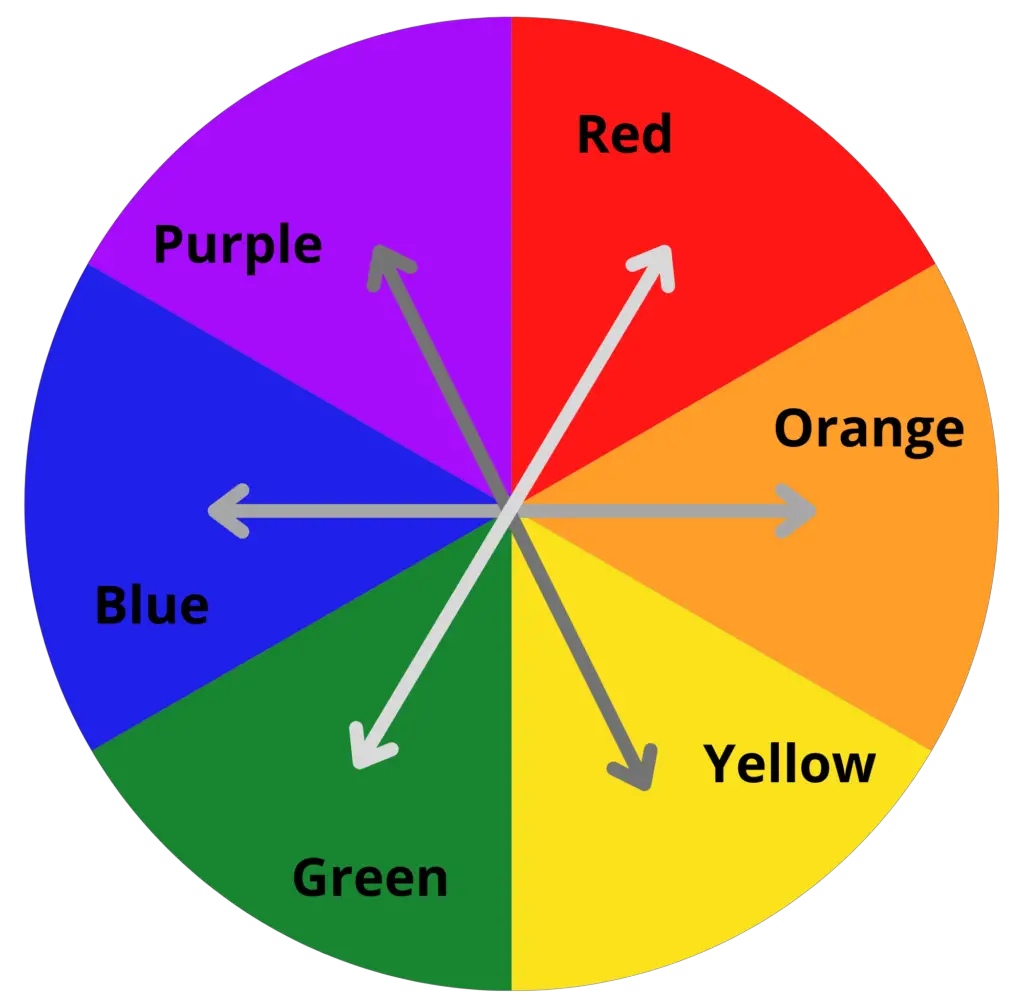
Other than using red and green as complementary colors, you can use purple or orange, and blue to mix tan as well. To make the purple color mix ultramarine blue and permanent alizarin crimson together. I will discuss in detail how to mix tan color and variations of it later in the article.
Color Terminologies
There are different color terminologies you need to understand when discussing colors. I have described them below;
Hue: Hue means colors such as primary colors( red, blue, yellow) and secondary colors (orange, green, purple).
Value: The darkness or lightness of a color. Every color has a value. You can see this if you see a black and white photo of colors. Light colors like yellow are high in value while darker colors like red are low in value. The color black has the lowest value while the color white has the highest value.
Shade: Shade is the darker color you get when mixing a hue (color) with black. You can make dark to light shades by mixing in more or less black.
Tint: Tint is the color you get by mixing a hue (color) with white. By changing the amount of white you mix, you can get lighter tints.
Mass stone: Color of paint when painted thickly, straight out of the tube without diluting.
Undertone: Undertone can be seen when you scraped the paint on a white surface. Undertones can be different from mass tones because colors are not pure although there is a single pigment. Impurities of some colors give a different undertone. (e.g. Phthalo blue has a dark blue mass tone and greenish undertone)
Color bias: Every color (even primary colors) has a bias towards another color because there are hidden color pigments in the pure colors. (e. g. Phthalo blue has a green color bias while ultramarine blue has either green or red color bias)
Complementary colors: Colors on the opposite side of the color wheel. When complementary colors are mixed, a neutral or muted color will be made.
Cool colors: Cool colors are colors that remind you of the ocean and water. They include blue, green, and purple.
Warm colors: Warm colors will remind you of sun and fire. They are red, orange and yellow.
What colors make tan without brown?
Tan can be made by mixing a yellow color with a gray color. An accurate tan color cannot be mixed using brown. The most common tan mixtures are using yellow ochre with a dash of red and green or using yellow ochre with a dash of purple (a mixture of ultramarine blue and permanent alizarin crimson).
The most commonly used brown colors when paintings are burnt or raw sienna or umber. But I do not use them when mixing tan or skin colors. Because brown colors can be mixed by mixing the complementary colors. You will just need a yellow base and complementary colors to make a skin color tone or tan color.
You can also make a tan color by mixing yellow ochre, cadmium scarlet, and ultramarine blue. Cadmium scarlet and yellow ochre will make an orange color. If you mix this orange color with its complement blue and titanium white you will end up with a grayish-yellow color or tan.
Tan can also be mixed with a lighter value of yellow ochre and purple made with ultramarine blue and permanent alizarin crimson. Yellow and purple are the complementary colors of the color wheel. You can see how these two colors look on a canvas from the below image.
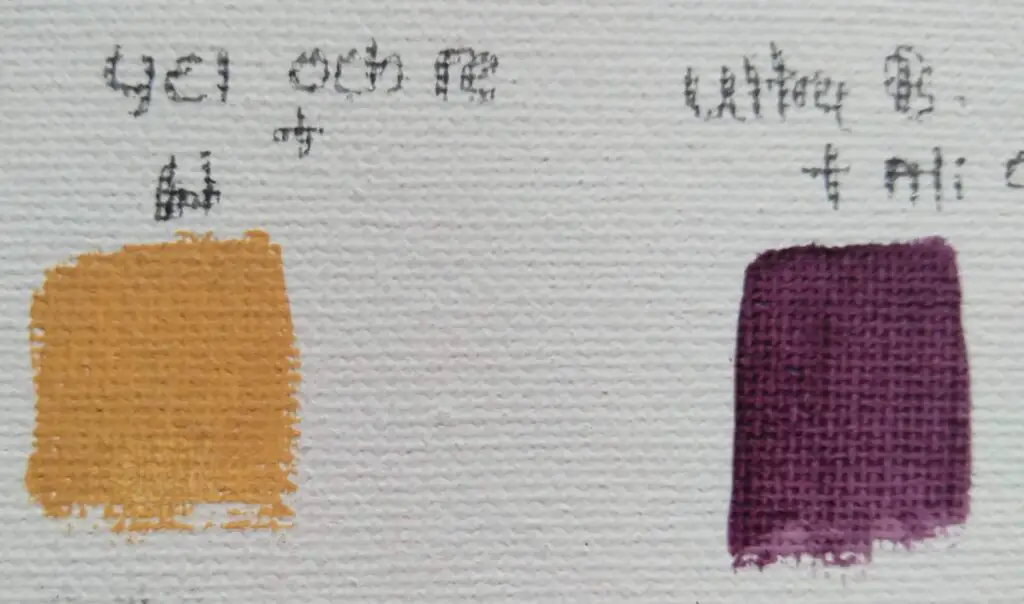
What color is tan?
Tan is used when we are talking about sunbathing or skin color. This name is derived from the oak bar (‘tannum’) that is used for tanning leather (converting raw animal skin into leather). Later the same process came into color as tan color.
Tan #D2B48C
Tan is a light brown color. It is used when someone is exposed themselves to the sun-light on the beach to darken the skin. It is called getting a tan. So this light brown color occurs in the skin after getting a tan or maybe naturally in skin colors.
ISCC–NBS system has named the color tan as ‘grayish yellow’ which is by far the best way to describe tan color. It will make it easier to mix tan as well.
What acrylic colors make tan?
You can mix the tan color by mixing the acrylic paints in the following table. What you have to do is mix color 1 with color 2 and add titanium white to lighten the mixture. These combinations can be used in acrylic, oil, and watercolor paint mixing.
| Color 1 | Color 2 |
| Yellow ochre mixed with more cadmium red | Prussian green |
| Yellow ochre mixed with a little cadmium red | Viridian |
| Yellow ochre mixed with more cadmium scarlet | Ultramarine blue |
| Yellow ochre mixed with a little cadmium scarlet | Ultramarine blue |
| Yellow ochre mixed with titanium white | Ultramarine blue and alizarin crimson mixture (purple) |
Color 1 and color 2 on the same row are complementary colors. So when they are mixed, a gray color will occur. When this gray color is mixed with a yellow base like yellow ochre and titanium white, a light grayish-yellow color will happen, just like a tan color.
I have also made a color mixing chart grid to make things easier for you. You just have to mix the colors indicated in the color mixing grid to make any skin color or variations of a tan color. You can download this color mixing chart grid below.
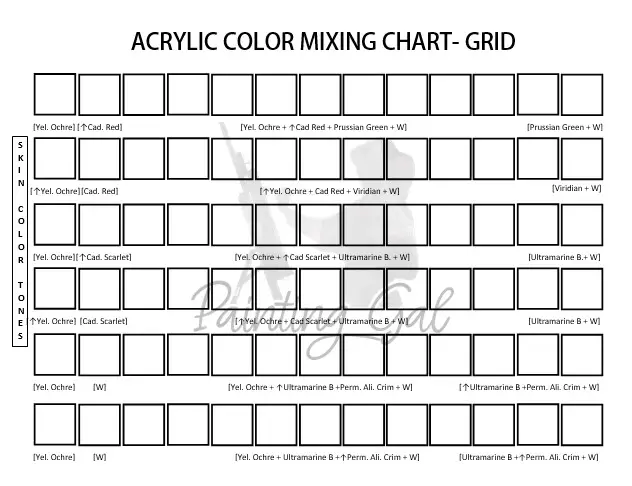
I have written a whole article about acrylic paint color mixing charts. You can learn a lot about mixing all the primary and secondary colors there. There is a free downloadable color mixing chart and a grid as well.
How to make the color tan with acrylic paint?
Now that we know what colors make tan in detail, let’s see how to mix the tan color with acrylic paint, step by step. Even though this guide is for acrylic paint, it can be easily adopted for oil paints or any other water-based paint as well.
Colors you will need
You will need the below colors to make different skin colors or tan colors.
- Titanium white
- Yellow ochre ( warm yellow base)
- Cadmium red (cool red)
- Cadmium Scarlet (warm red)
- Prussian green (warm green)
- Viridian (cool green)
- Ultramarine blue (warm blue)
- Permanent alizarin crimzon (cool red)
The truth is you do not need all of these colors to make a tan color. You only need titanium white and yellow ochre as the must-have colors. Then you need to have complementary colors. You can find the complementary colors in the above table with color 1 and color 2 columns.
Step of mixing tan with acrylic paint
Now follow the below steps one by one and you will end up with a beautiful tan color. These colors can be used for skin colors as well. Here I will be using only two complementary color combinations. You can use other complementary color combinations in the above table in the same manner as well.

Step 1: Mix a light value of yellow ochre
Take a large blob of yellow ochre onto your palette, and mix it with titanium white until you get a slightly lighter value. This is our base yellow mixture. You can mix a little titanium white when you need color with darker value. When you need color with a lighter value, mix more titanium white.
Step 2: Mix the complementary color-purple
On two separate places on the palette mix permanent alizarin crimson and ultramarine blue. Mix a warm purple color by adding more alizarin crimson and mix a cool purple by mixing more ultramarine blue. Although both are purple colors you will get different results with the temperature change.
I have also tried another purple mixture. It is mixing phthalo blue with cadmium red. The mixture is darker in value and more muted and opaque compared to the alizarin crimson and ultramarine blue mixture.

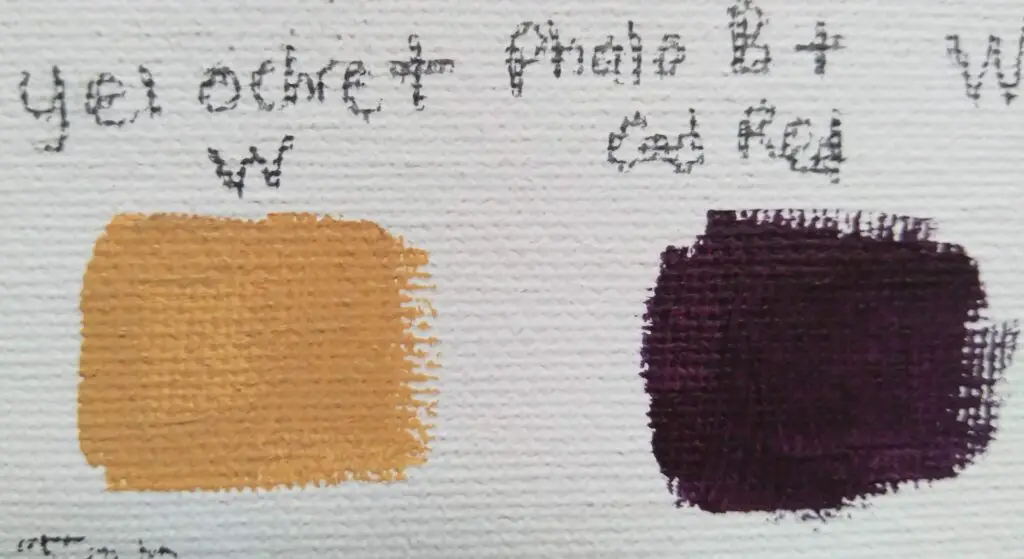
Step 3: Mix the complementaries
Now mix a dash of cool and warm purple colors separately on the palette with the yellow ochre mixture. The color mixing chart grid I have provided will help you with putting down different hues of tan or gray colors that you get along the way.
Step 4: Adjust the color temperature and value to make the tan color
Now change the amount of titanium white, yellow ochre, and the purple color you mix in until you get a tan color. Adding more white to a mixture will lighten a color in value, at the same time, it will desaturate a color. When there is white there are more white pigments than the color pigment, thus it will become a desaturated color.
However, when you look at the tan color it is very light in value. Also, it is a cool color. So you can adjust the amount of purple in the mixture as well. You will get different hues and tints of a tan color. If you are painting a portrait all of these colors will be super important to make changes in value.
Below I have included different skin colors and tan colors I have mixed. I have included the color palette I got by mixing purple color as a complementary color. One purple color is mixed using ultramarine blue and permanent alizarin crimson. Another purple color is mixed using phthalo blue and cadmium red.


Step 5: Use a color picking app to detect the mixed color
One of the biggest challenges when color mixing is checking if you have mixed the right color. The easiest way is using a color picker app on your mobile phone. These apps can detect the color on your palette or any other surface pretty accurately. It will show you a percentage of how accurately you have matched a color.
Color matching is easy again if you have reference material. In other cases, the best option would be using a color-picking app. There are many good ones out there.
What colors make tan skin tone?
Tan skin tone can be mixed using yellow ochre, titanium white, green and red colors. It is a grayish-yellow color. The value of tan color can be changed by mixing white color. Temperature can be changed by mixing different ratios of green (cool) and red (warm) colors.
What colors make skin color?
Portrait paintings or skin color paintings can be overwhelming when you are a beginner. Because there are so many variations happening in the skin. So we will need to mix so many different skin tones as well. But when you know the right process of mixing skin colors the painting process will be easier.
Determine the general tone of the skin…
Every individual is different so are their skin tones. The first thing you need to do when painting a portrait or skin is to determine the main skin tone. It can be more toward red, yellow, or orange. So you need to determine if one’s skin tone has a red, yellow, or orange bias.
This main skin tone can differ according to ethnicity. For Caucasian women, the skin will have a red bias. Most Asian and African women’s skins are more towards the yellow color. The main tone can be darker or lighter in value according to the person.
Now you need to mix the main skin tone with a base skin color. As a base skin color, what I use is yellow ochre. Now, you need to mix the general skin tone if it is red or orange with yellow ochre. You can lighten the value of the color by mixing it with white.
If the skin has a yellow color bias, then mixing yellow ochre with titanium white will be enough.
Mix the gray tones of the general skin tones…
In nature, you will not see the pure colors of this general tone. You will see muted oranges, reds, and yellows in the skin as well as the nature. To mute a color you need to mix it with the complementary color. I have listed all the complementary colors in the above table.
Now you need to mix the base skin tone color with its complementary colors as indicated in the table above. It will make a range of cool and warm grays. You can make a color warmer by mixing more of the warm color and a color cooler by mixing more of the cooler color.
The value of the color can be reduced by mixing white. If you want darker values of a color, mix more of the darker color. Below I have included an image of different skin tones I have obtained with green, yellow ochre, titanium white, and cadmium red.
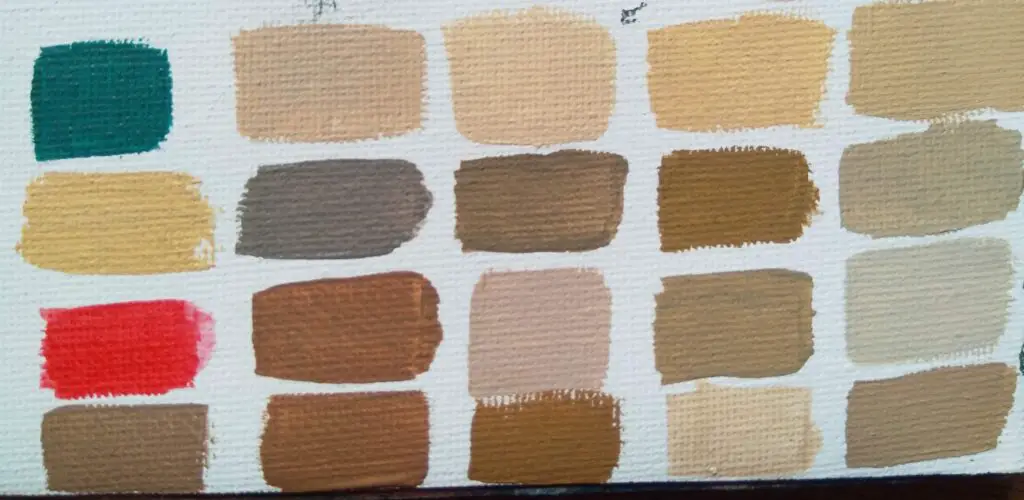
Apply the skin tones on the painting surface and blend…
The final step is applying the mixed skin tones on the canvas. If you have a reference photo you can take a printout of it. Get a black and white image and you will see the change of values in the skin. Now you need to match these values in the skin with the gray colors you mixed.
Apply swatches of these gray colors onto the skin matching the reference photo values. You need to match the temperature of the colors as well. If a warm light is hitting on a subject, you need to paint the shadows cooler. If there is a cool light, the shadows will be warmer. This avoids a painting being flat or chalky.
Once you have matched the values and temperature of the painting you can blend these colors. Blending is easy with oil paint. But if you are using acrylic paint, use a glazing medium for seamless color blending.
You can add a middle color if there are more bold changes of color on the skin. If you matched the values and temperatures right you are almost done with your painting. Making skin colors is the same process as making tan colors. Tan is also a skin tone when you get after exposure to sunlight.
What colors make brown?
Brown can be made by mixing complementary colors; green and red, purple and yellow, orange and blue together. Take a large amount of the warm color and mix a little of the cool color into it. Then change the value by mixing more white.
Another tip you need to keep in mind when mixing brown is that, mixing a little cool color into the warm color. By doing so you can save a lot of paint. Because a little cool color can mute a warmer color easily. You can mix cool brown with cool colors and warmer brown with more of the warmer color.
What colors make beige?
Beige is made by mixing yellow ochre and titanium white with complementary colors. These can be green and red, blue and orange or purple. Yellow ochre gives a brownish yellow color while the complementary colors add gray to the mix.
Beige #F5F5DC
Beige is sometimes known as a grayish tan color. It is a very light yellowish-grayish brown color. Tan goes very close to the beige color, but they are different. Beige is paler and grayer than tan color.
You can mix any brown hue this way. Change the value and temperature, you will end up with interesting skin tones and tan colors for the artwork.
Conclusion
Accurate color mixing is a skill you have to master when doing paintings. Tan can be mixed using a yellow base with a complemnatry color. Then change the value of the color by mixing it with white. The temperature of color can be changed by mixing different ratios of cool and warm colors.

